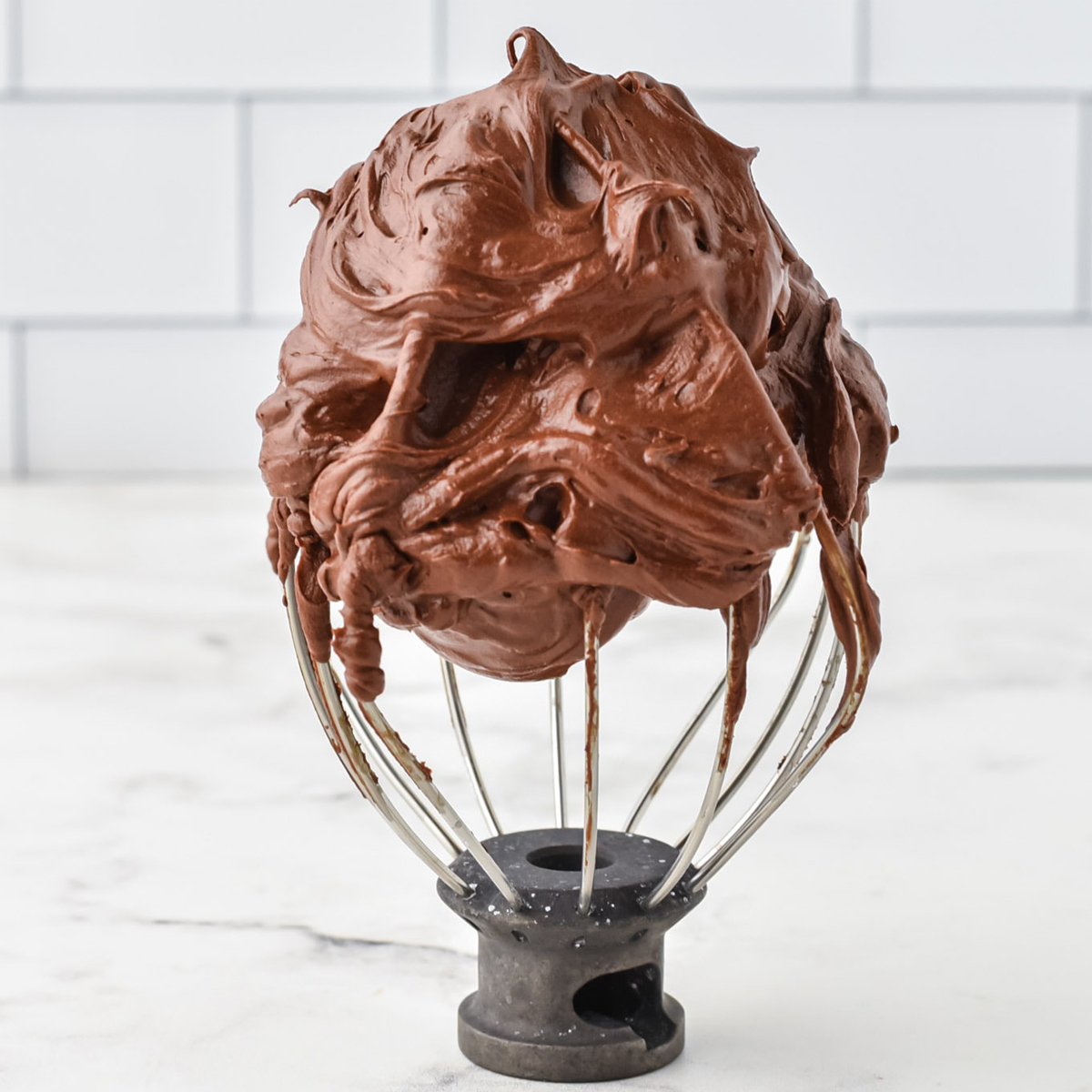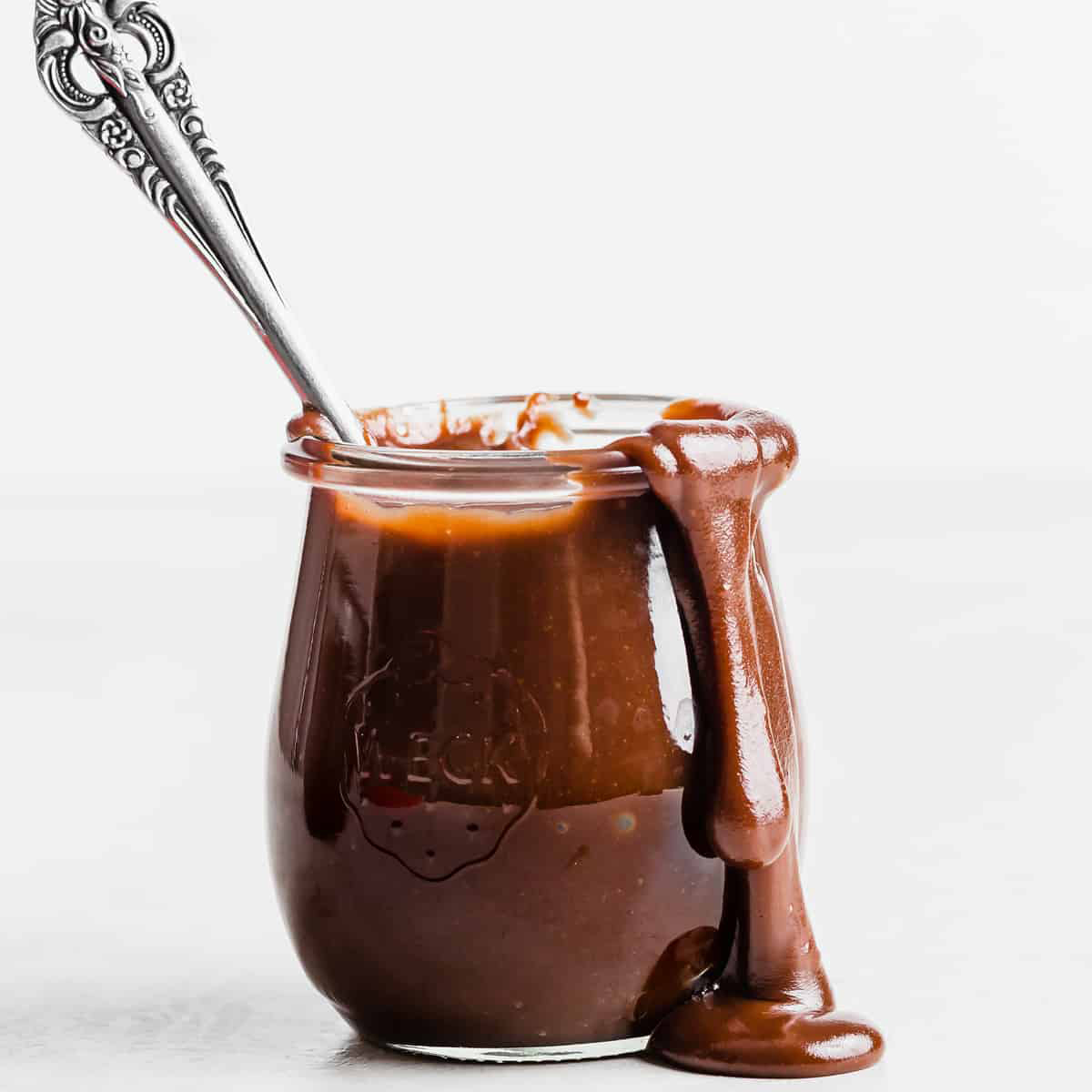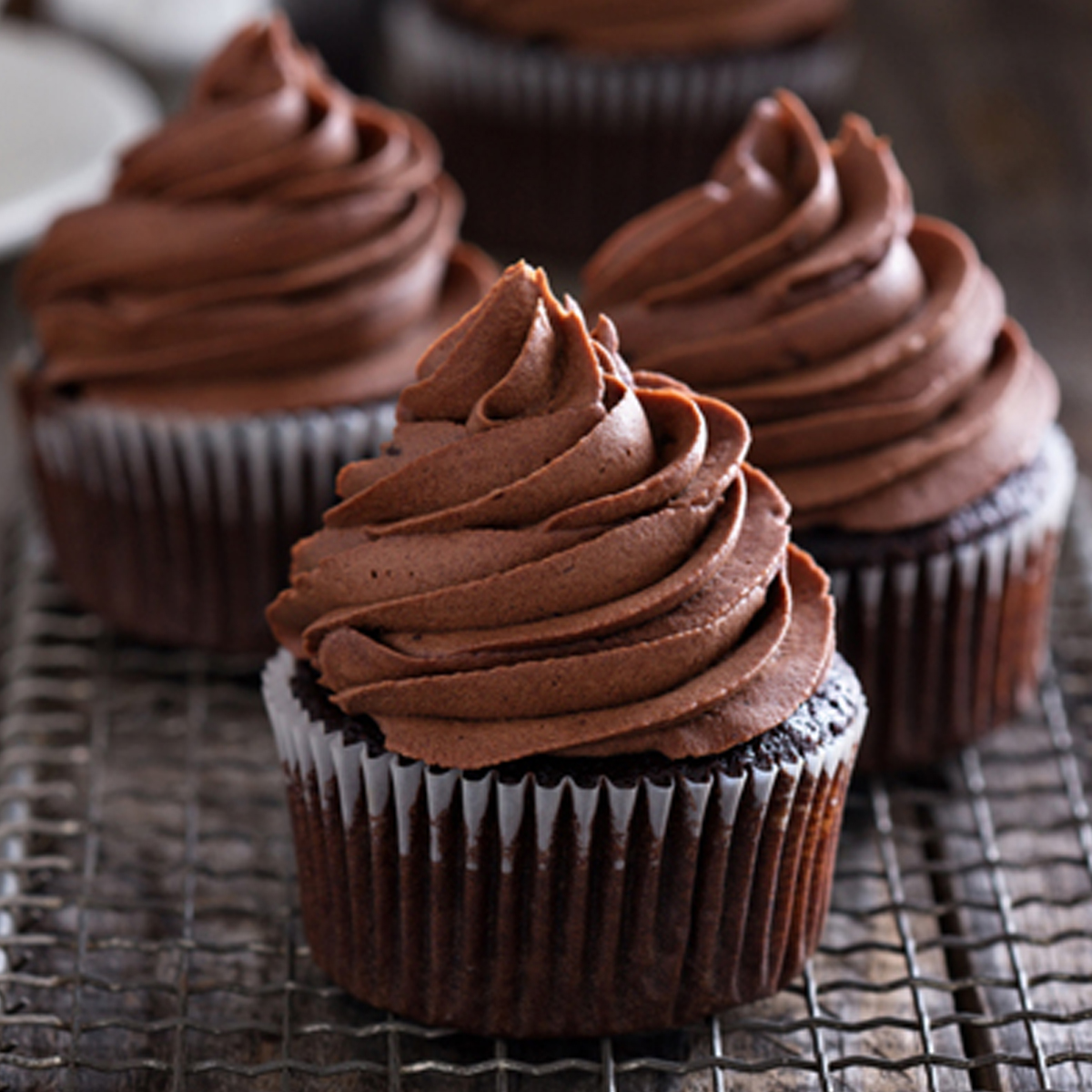Fudge is a delightful and indulgent treat that has been cherished by sweet-toothed individuals for generations. This classic confection is beloved for its smooth and creamy texture, combined with a rich, chocolaty flavor that melts in your mouth. Whether enjoyed as a homemade gift, a holiday treat, or a comforting dessert, fudge has a way of bringing joy to every occasion.
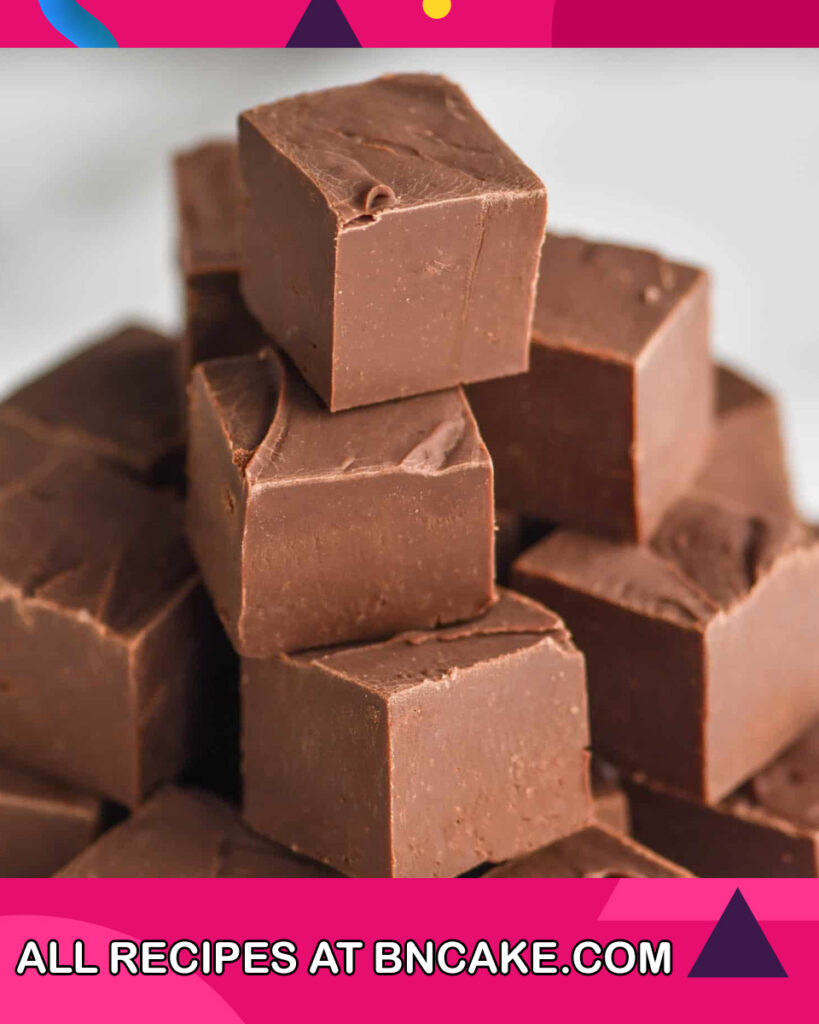
The beauty of fudge lies in its simplicity, with just a handful of ingredients coming together to create something truly magical. The basic fudge recipe typically calls for butter, sugar, evaporated milk, and chocolate, although variations abound, allowing for customization to suit personal tastes and preferences. Nuts, marshmallows, peanut butter, or even spices can be added to create unique and delightful flavor combinations.
Making fudge is a delightful culinary adventure that can be enjoyed by bakers of all skill levels. However, achieving that perfect, velvety consistency can require some practice and precision. The key lies in carefully monitoring the cooking process, ensuring the mixture reaches the right temperature and is properly stirred to prevent graininess.
In this introduction to fudge recipes, we will explore the basic steps and techniques needed to create a delectable batch of homemade fudge. So whether you’re a seasoned dessert enthusiast or a beginner looking to embark on a sweet endeavor, get ready to savor the joys of crafting your very own mouthwatering fudge delights. Indulge yourself and share this delightful treat with loved ones, as there’s no better way to spread happiness than with a batch of freshly made fudge.
What Is Fudge?
A Fudge is a set of instructions and ingredients used to make fudge, a popular confectionery treat known for its smooth and creamy texture and rich flavor. Fudge recipes typically involve combining butter, sugar, milk (often evaporated milk), and chocolate or cocoa powder. The mixture is heated and stirred until it reaches a specific temperature, at which point it is allowed to cool and set, resulting in the characteristic soft and indulgent fudge.
While the classic fudge recipe is chocolate-based, there are numerous variations that incorporate different flavors and add-ins, such as nuts, marshmallows, peanut butter, fruits, or even spices. This versatility allows for endless creativity and customization in the world of fudge making.
Fudge recipes may vary slightly in terms of ingredients and techniques, but the essential process involves dissolving sugar in a fat (usually butter) and milk, then adding chocolate or cocoa to create a smooth mixture. The mixture is then heated and boiled until it reaches a specific temperature known as the “soft-ball stage,” typically around 235 to 240 degrees Fahrenheit (113 to 116 degrees Celsius). The mixture is then vigorously beaten or stirred to induce crystallization, resulting in a smooth and creamy fudge.
Fudge recipes can be found in cookbooks, online resources, or shared among family and friends. Making fudge can be a fun and rewarding activity, but it requires some precision and attention to detail to achieve the desired texture and taste. Once made, fudge can be cut into squares or shapes and enjoyed as a delectable treat for special occasions, holidays, or simply as a delightful way to satisfy a sweet craving.
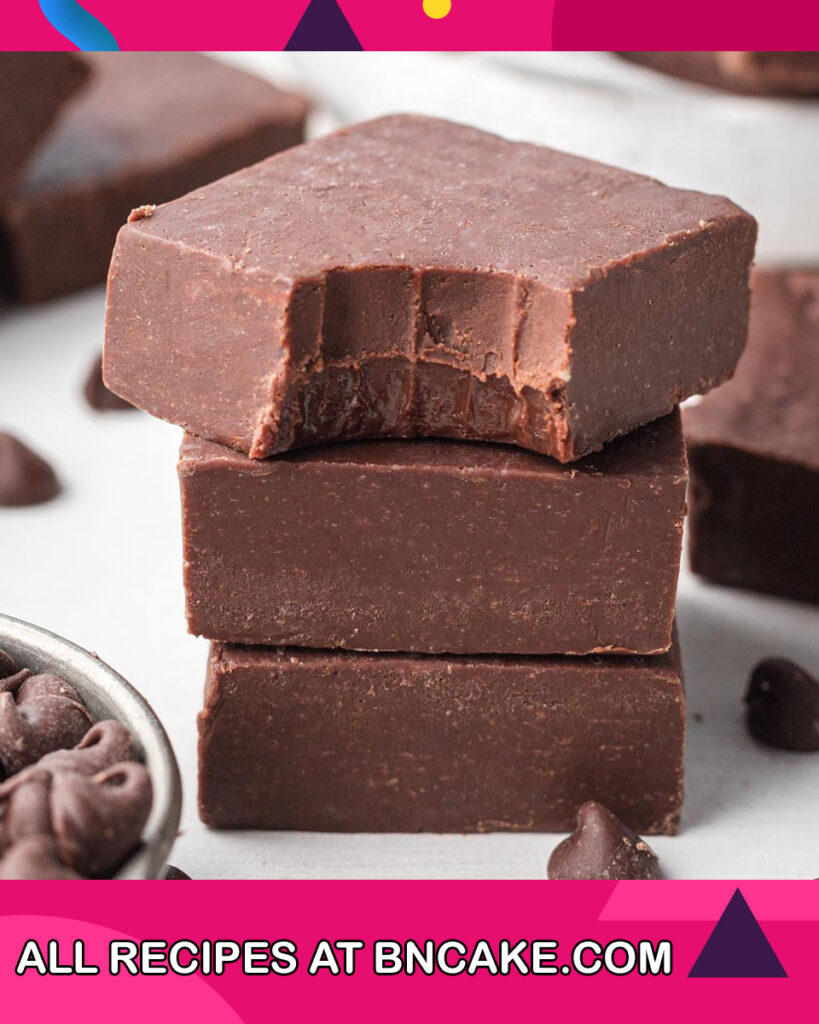
Why You Will Love Fudge Recipe?
- Indulgent Delight: The Fudge Recipe offers a delectable and irresistible treat that is sure to satisfy your sweet tooth. With its rich and creamy texture and luscious chocolate flavor, fudge is the perfect indulgence for any dessert lover.
- Easy to Make: Despite its luxurious taste, making fudge is surprisingly straightforward. The Fudge Recipe provides clear and simple instructions, making it accessible to bakers of all levels. Whether you are an experienced cook or a novice in the kitchen, you can easily whip up a batch of homemade fudge to impress your friends and family.
- Versatility: The beauty of the Fudge Recipe lies in its versatility. While the classic version is delightful on its own, you can unleash your creativity and experiment with various flavors and add-ins. Whether you prefer nuts, marshmallows, or a swirl of peanut butter, the Fudge Recipe allows you to customize your fudge to suit your unique taste preferences.
- Homemade Delights: There’s something special about homemade treats, and fudge is no exception. With the Fudge Recipe, you can create a heartfelt gift for your loved ones or whip up a delightful dessert for special occasions. The joy of sharing homemade fudge will surely warm the hearts of those who receive it.
- Crowd-Pleaser: Fudge is a universally loved confection that appeals to people of all ages. Whether you’re hosting a party, a family gathering, or just treating yourself, the Fudge Recipe is sure to be a crowd-pleaser, making you the star of any event.
- Aromatic Experience: As you prepare the fudge, your kitchen will be filled with the heavenly aroma of chocolate and butter, creating a delightful atmosphere that adds to the joy of baking.
- Memorable Moments: The process of making fudge can be a fun and memorable experience. Whether you’re cooking with friends, family, or on your own, the Fudge Recipe allows you to create cherished moments and lasting memories.
In conclusion, the Fudge Recipe is a delightful and versatile treat that brings joy to both the maker and the lucky recipients. With its simplicity, versatility, and delicious results, it’s no wonder why the Fudge Recipe is a beloved classic that continues to be cherished by dessert enthusiasts around the world.
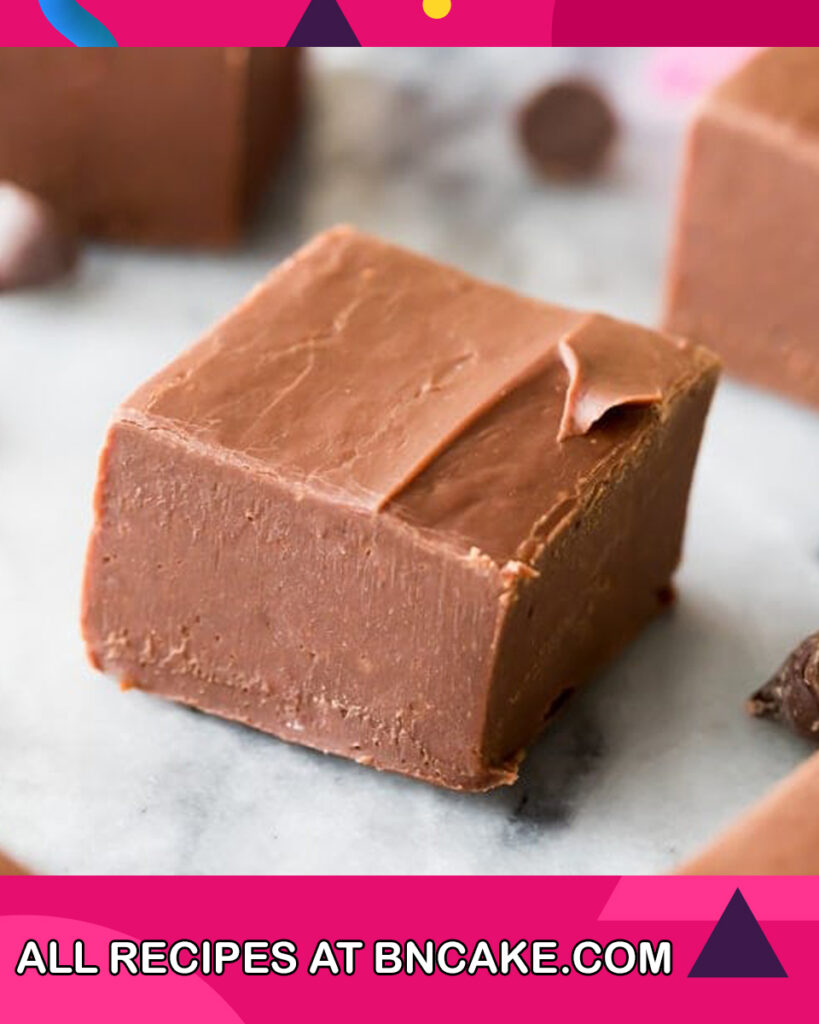
Ingredients For Fudge
- 2 cups granulated sugar
- 1 cup unsalted butter (2 sticks)
- 1 cup evaporated milk (or heavy cream)
- 1 teaspoon vanilla extract
- 1/4 teaspoon salt
- 3 cups semi-sweet chocolate chips (or chopped chocolate)
- 1 cup chopped nuts (optional, such as walnuts or pecans)
How To Make Fudge
- Prepare Pan: Grease an 8×8 inch (20×20 cm) square baking pan or line it with parchment paper.
- Combine Ingredients: In a heavy-bottomed saucepan, combine the granulated sugar, unsalted butter, evaporated milk (or heavy cream), and salt.
- Boil and Stir: Place the saucepan over medium heat, stirring constantly until the butter melts and the sugar dissolves. Bring the mixture to a gentle boil, stirring continuously.
- Monitor Temperature: Use a candy thermometer to monitor the temperature. Cook the mixture until it reaches the “soft-ball stage,” which is around 235 to 240 degrees Fahrenheit (113 to 116 degrees Celsius).
- Remove from Heat: Once the mixture reaches the soft-ball stage, remove the saucepan from the heat source immediately.
- Add Chocolate and Vanilla: Stir in the semi-sweet chocolate chips (or chopped chocolate) and vanilla extract until the chocolate is completely melted and the mixture becomes smooth and glossy.
- Optional: Add Nuts: If desired, you can now stir in the chopped nuts to add texture and flavor to your fudge.
- Pour into the Pan: Quickly pour the fudge mixture into the prepared pan, spreading it evenly with a spatula.
- Cool and Set: Allow the fudge to cool at room temperature until it sets and becomes firm. This may take a couple of hours.
- Cut and Serve: Once the fudge is completely set, cut it into small squares or rectangles using a sharp knife.
- Store: Store the fudge in an airtight container at room temperature for up to two weeks. Alternatively, you can refrigerate it to extend its shelf life.
Now you have the detailed formula for making delicious homemade Fudge! Enjoy this delightful treat and share it with your friends and family to spread the joy.
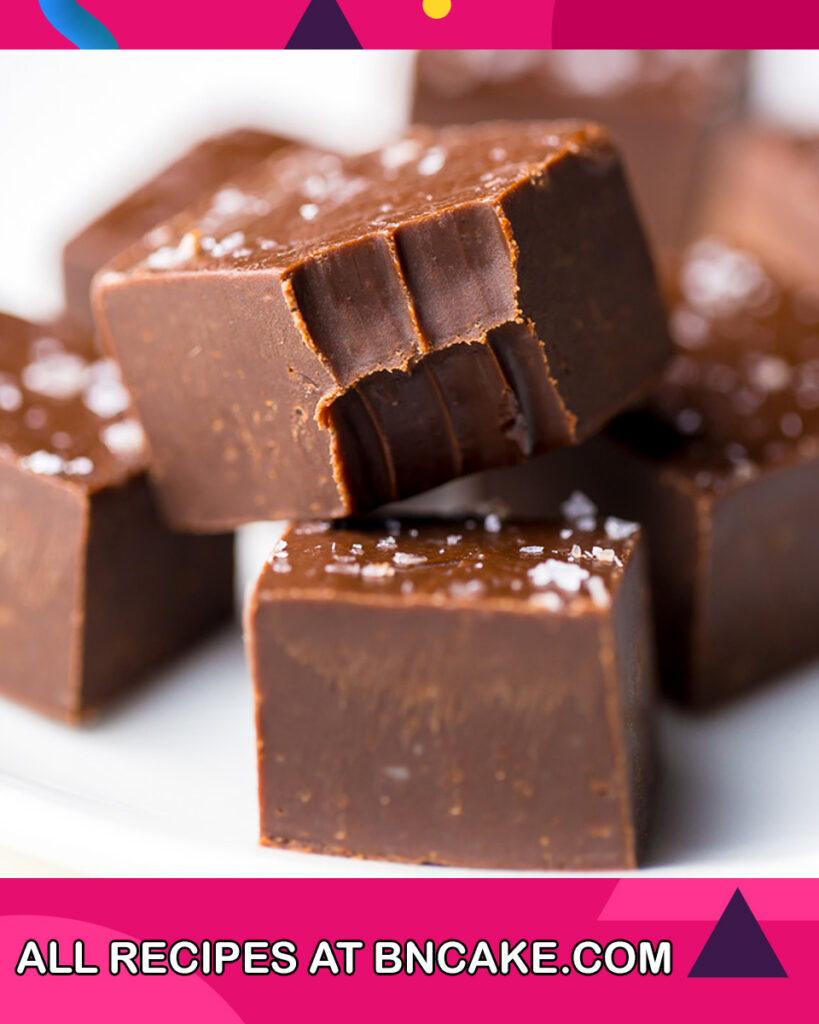
How To Serve Fudge
Serving Fudge is a delightful and straightforward process. Once you’ve made a batch of delicious homemade Fudge using the recipe provided, follow these steps to present and enjoy this delectable treat:
1. Cut into Pieces: After the Fudge has completely cooled and set in the pan, carefully lift it out using the parchment paper (if used) and place it on a cutting board. Use a sharp knife to cut the fudge into small squares or rectangles. The size of the pieces can vary depending on your preference, but bite-sized portions are generally perfect for serving.
2. Presentation: Arrange the cut Fudge pieces on a serving platter or in an airtight container. If you’d like to make the presentation more visually appealing, consider dusting the fudge squares with a light sprinkle of cocoa powder, powdered sugar, or edible glitter.
3. Accompaniments (Optional): Fudge is delightful on its own, but you can add some additional elements to enhance the serving experience. Consider serving the Fudge with a side of fresh berries, a dollop of whipped cream, or a scoop of ice cream. These accompaniments complement the fudge’s sweetness and offer a nice contrast in flavors and textures.
4. Serve at the Right Temperature: Fudge is best served at room temperature or slightly warmed. If you refrigerated the Fudge, allow it to sit at room temperature for a few minutes before serving to bring out its full flavor and creamy texture.
5. Enjoy and Share: Once the Fudge is beautifully arranged and accompanied (if desired), it’s time to enjoy the delectable treat! Invite your friends and family to savor the homemade delight together. Fudge also makes a thoughtful gift, so consider sharing some with your loved ones or bringing it to a gathering or party.
6. Storage (if any leftovers): If there are any leftover Fudge pieces, store them in an airtight container at room temperature. Properly stored, homemade Fudge can stay fresh and enjoyable for up to two weeks. However, it is unlikely that they will last that long, given how irresistible they are!
Note: Fudge can become quite soft in warm weather, so if you’re serving it outdoors during hot temperatures, try to keep it in a shaded and cool area to maintain its shape and texture.
Now, you’re ready to serve and savor the delightful homemade Fudge. Enjoy the delicious treat and share the joy with those around you!
How To Store Fudge
Properly storing Fudge is essential to maintain its freshness, texture, and flavor over time. Here are some guidelines on how to store the Fudge:
- Cooling and Setting: After making the Fudge using the recipe provided, allow it to cool completely in the pan until it sets and becomes firm. This may take a couple of hours at room temperature.
- Cut and Separate: Once the Fudge has set, cut it into small squares or rectangles using a sharp knife. This will make it easier to store and serve individual portions later.
- Airtight Container: Transfer the cut Fudge pieces into an airtight container. Make sure the container is clean and dry to prevent any moisture from affecting the fudge’s texture.
- Layering: If you need to store multiple layers of Fudge, separate each layer with parchment paper to prevent sticking and maintain the appearance of each piece.
- Room Temperature Storage: If you plan to consume the Fudge within a week, it’s safe to store it at room temperature. Place the airtight container in a cool, dry place, away from direct sunlight or heat sources. Room temperature storage helps maintain the fudge’s soft and creamy texture.
- Refrigeration (Optional): If you anticipate keeping the Fudge for more than a week or if your climate is particularly warm and humid, you can refrigerate it to extend its shelf life. Refrigeration helps prevent the fudge from becoming too soft or melting. Just remember to bring the Fudge back to room temperature before serving to enjoy its full flavor and texture.
- Freezing (Optional): Fudge can also be frozen for longer-term storage. Wrap the cut Fudge pieces individually in plastic wrap or wax paper, then place them in an airtight container or a freezer-safe bag. Properly stored, frozen Fudge can remain fresh for several months. To thaw, transfer the Fudge to the refrigerator overnight or let it come to room temperature gradually.
Note: Avoid storing Fudge in the refrigerator or freezer alongside strongly scented foods, as Fudge can absorb odors easily.
Remember that the Fudge’s texture and flavor may change slightly over time, but it should still be enjoyable even after several days of storage. Just make sure to use a clean utensil each time you take out the Fudge to avoid any contamination.
By following these storage tips, you can keep your homemade Fudge fresh and delicious, allowing you to savor this delightful treat over an extended period. Enjoy your Fudge whenever you crave a sweet and indulgent treat!
If You Love This Recipe Try These Out!
Tips And Tricks For Fudge
Here are some helpful tips and tricks to ensure your Fudge Recipe turns out perfectly:
1. Use a Candy Thermometer: Invest in a reliable candy thermometer to accurately monitor the temperature of the fudge mixture while boiling. This will help you achieve the precise “soft-ball stage” and prevent undercooking or overcooking, leading to the perfect fudge texture.
2. Stir Constantly: Stir the fudge mixture continuously while it’s boiling to prevent it from sticking to the bottom of the pan and burning. Stirring also helps distribute heat evenly and ensures a smooth and creamy consistency.
3. Avoid Overcooking: Be attentive to the cooking process and avoid boiling the mixture past the soft-ball stage. Overcooking can result in grainy or crumbly fudge, which is not as enjoyable as the smooth version.
4. Soften Butter: Allow the butter to reach room temperature before using it in the recipe. Softened butter mixes more easily with other ingredients, leading to smoother fudge.
5. Use Good Quality Chocolate: Opt for high-quality chocolate or chocolate chips to enhance the fudge’s taste and texture. The better the chocolate, the richer and more decadent the fudge will be.
6. Customize Add-Ins: Experiment with various add-ins to personalize your fudge. Nuts, marshmallows, dried fruits, or different types of chocolate can add exciting flavor combinations and textures to the fudge.
7. Beat Vigorously: Once you add the chocolate and vanilla, beat the mixture vigorously to encourage smooth crystallization and ensure a creamy fudge.
8. Set and Cut Properly: Allow the fudge to cool completely and set before cutting it into pieces. Cutting too early can result in messy edges and uneven shapes.
9. Parchment Paper Trick: Line the baking pan with parchment paper, extending the edges over the sides. This makes it easier to lift the fudge out of the pan, aiding in clean cuts and presentation.
10. Store Wisely: Store the fudge properly in an airtight container to maintain freshness. Separate layers with parchment paper to prevent sticking if stacking multiple layers.
11. Gifting: Homemade fudge makes a thoughtful gift. Consider packaging it in a decorative box or tin, tied with a ribbon or bow, to give it an extra touch of charm.
12. Practice and Patience: Making perfect fudge may take some practice. Don’t be discouraged if your first attempt isn’t flawless. Learn from the process and adjust as needed for future batches.
By following these tips and tricks, you’ll be well on your way to creating delectable and impressive homemade fudge that will impress friends and family alike. Enjoy the sweet rewards of your efforts and have fun experimenting with different flavors and add-ins!
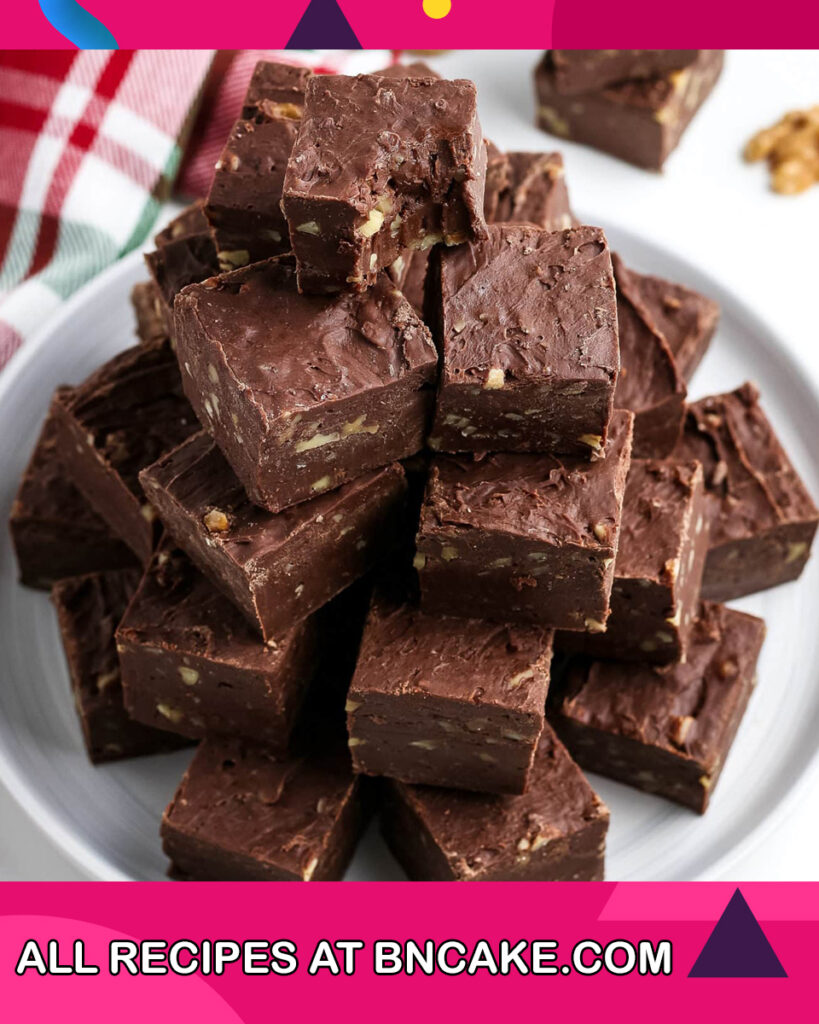
FAQs And Troubleshooting About Fudge
1. Why did my fudge turn out grainy?
Grainy fudge is often the result of sugar crystals not fully dissolving during the cooking process. To prevent this, ensure you stir constantly while boiling and avoid scraping the sides of the pan, as sugar crystals on the sides can cause crystallization. Using a candy thermometer to achieve the precise soft-ball stage can also help reduce the chances of graininess.
2. My fudge didn’t set properly. What went wrong?
If your fudge didn’t set properly, it may not have reached the correct temperature during boiling. Make sure to cook the mixture to the soft-ball stage, around 235 to 240 degrees Fahrenheit (113 to 116 degrees Celsius). Additionally, avoid over-stirring after adding the chocolate and vanilla, as excessive stirring can prevent the fudge from setting properly.
3. Can I use salted butter instead of unsalted butter?
Using salted butter can alter the overall taste of the fudge, making it slightly saltier than desired. It’s best to use unsalted butter, as it allows you to control the amount of salt in the recipe.
4. Can I substitute evaporated milk with condensed milk?
While both evaporated milk and condensed milk are dairy products, they are not interchangeable in this recipe. Condensed milk is sweetened and much thicker than evaporated milk, which can significantly affect the fudge’s texture and sweetness. Stick to using evaporated milk or heavy cream for the best results.
5. Can I make fudge without a candy thermometer?
While a candy thermometer is highly recommended for accuracy, you can still make fudge without one by using the soft-ball test. Drop a small amount of the fudge mixture into a bowl of ice water. If it forms a soft ball that can be squished between your fingers, it has reached the soft-ball stage.
6. Can I store fudge in the refrigerator?
You can store fudge in the refrigerator to extend its shelf life, especially in warmer climates. However, refrigeration can cause the fudge to become slightly firmer. To enjoy the fudge’s smooth texture, bring it to room temperature before serving.
7. Can I freeze fudge?
Yes, you can freeze fudge for longer-term storage. Wrap individual fudge pieces in plastic wrap or wax paper and place them in an airtight container or freezer-safe bag. Thaw frozen fudge in the refrigerator overnight or at room temperature.
8. My fudge is too soft and sticky. How can I fix it?
If your fudge is too soft or sticky, it may have been undercooked or not cooled sufficiently. Reheat the fudge mixture in a saucepan over low heat, stirring constantly until it reaches the soft-ball stage again. Allow it to cool and set properly before cutting and serving.
Remember that making fudge may require some practice, and it’s normal to encounter challenges along the way. Troubleshooting and learning from each attempt will help you perfect your fudge-making skills and create delightful batches of this sweet treat.
Nutrition Information
Calories: Approximately 110-120 calories, Total Fat: Around 6-8 grams, Saturated Fat: Approximately 4-5 grams, Cholesterol: Around 10-15 milligrams, Sodium: Roughly 25-30 milligrams, Total Carbohydrates: Approximately 14-16 grams, Dietary Fiber: Around 1 gram, Sugars: Approximately 13-15 grams, Protein: Roughly 1-2 grams
Please note that these values are approximate and can vary depending on the specific ingredients used and the serving size. If you’re looking for more precise nutrition information, you may need to calculate it based on the exact brands and measurements you use in your Fudge Recipe.
It’s essential to enjoy fudge in moderation due to its high sugar and fat content. As with any treat, it’s best to savor it as part of a balanced diet and active lifestyle.


